 |
RICHMOND GAOL (1825) – Richmond Gaol was built in 1825 as part of Governor Arthur’s system of police districts. The building was added to in the 1830s and was last used as a gaol in 1928. One of its infamous inmates was convict Ikey Solomon, said to be the model for Dicken’s Fagin. The gaol is open daily for inspection. |
 |
Hollyhock Cottage (1830)- is a brick and timber cottage, one of only a few to have survived to the present day. It is thought that because the south facing wall containing two chimneys is built of brick (convict) this reduced the risk of fire spreading from the two hearths. The original construction of the cottage is thought to be associated with the discovery of low grade coal in the valley and anecdotal information suggests that it has been referred to as a ‘Miners Cottage’.
|
 |
“TEDDIES ON THE GREEN” – MILLER’S COTTAGE (c1837) – Miller’s Cottage was associated with the Providence Mill (c1830) which stood between the cottage and the riverbank. The Mill was not a successful project, even when it was changed to steam some years later. It was derelict for many years, and was finally demolished in 1908. |
 e e |
“PEPPERCORN GALLERY” – MILL COTTAGE (c1850) – Built as a shop for the Misses Moran, the cottage was later a boot maker’s shop and now houses the “Peppercorn Gallery”. |
 |
“POPLAR COTTAGE” – 49 BRIDGE STREET – Now known as “Poplar Cottage”, it was originally a pair of conjoined cottages. The building is now used as colonial bed and breakfast accommodation. |
 |
“LOCH LOMOND” – 47 BRIDGE STREET– “Loch Lomond” is a pair of conjoined cottages thought to have been associated with the building of the Richmond Bridge. The cottages are one room wide and two deep. For many years, the building had only one door. The building is now used as colonial bed and breakfast accommodation. |
 |
COLONIAL COTTAGES & FORMER SHOP (c1840s) |
 |
FORMERLY BAKEHOUSE (c1830) – This was once part of P.J. Nichols’ Store, which stood near the site of the current supermarket. The store burnt down in the 1920s. A baker operated from the old bakery until the mid-1970s. |
 |
RICHMOND COURT HOUSE – The Court House was built in 1825 as part of Governor Arthur’s system of police districts. Before the churches were built it was also used for church services. In 1861, when the Richmond Municipality was established, it was used as Council Chambers. It was used as for this purpose until 1993 when Richmond Council amalgamated with Clarence City Council. |
 |
RICHMOND TOWN HALL – The Town Hall was built in 1908 from recycled stone from derelict and demolished buildings, including the Providence Mill and the Police Barracks. The Police Barracks were built in 1833 on a site roughly in the car park behind the Hall. |
 |
BRIDGE INN – This site was originally a one-storey building (c1817) known as the Richmond Wine Vaults. It was continuously licensed as an hotel from 1834 until 1975. In 1985 it was restored to its external 1830s appearance and shops were incorporated into it. It now houses “Sweets & Treats” and part of the “Saddlers Court” complex. |
 |
“SADDLERS COURT” – “Saddlers Court” was originally a general store and later a saddlery. In 1968 it was restored by Alice Krongaard and opened as the first gallery in Richmond. |
|
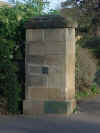
|
GATEPOST – This pillar marks the entrance to the old saleyards. |
 |
“MRS. CURRIE’S HOUSE” – FORMERLY “PRINCE OF WALES HOTEL” – Licensed from 1849 it operated as a hotel until the turn of the century. The front of the building was added in the early 1860’s. The house is named after former owner Mrs Currie (nee Cooley). The building is now used
as bed and breakfast accommodation. |
 |
VILLAGE STORE – Built for the Gaby family c1836, the building still houses the village store. The stable, to the left of the store, is a separate building. Blacksmiths and wheelwrights operated where the car park now is. It is believed to be one of the oldest general stores still in use in Tasmania. |
 |
“MA FOOSIES” – FORMERLY A COLONIAL SHOP (c1830) – This building has had many uses in the past – bakery, butcher shop, doctor’s surgery. |
 |
“RICHMOND ARMS” – FORMERLY”COMMERCIAL HOTEL” (1888) – This hotel was built to replace the earlier “Lennox Arms” which was built in 1827 and stood slightly to the right of the present
hotel. The name was changed to the “Richmond Arms” in 1972. The old stable in the car park is all that remains of the original inn. |
|
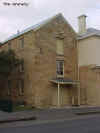
|
THE GRANARY (c1829) –
During the middle of the last century this building was used to store grain before it was shipped to Hobart and Sydney by barge along the Coal River. |
 |
“RICHMOND TOWN & COUNTRY” – FORMERLY BUSCOMBE’S STORE & POST OFFICE – Originally a single-storey building built c1826, it was added to by James Buscombe in the 1830s and was used as a store. It served as the Post Office for many years. |
 |
CONGREGATIONAL CHURCH (1873) –
The first Congregational Church was built in 1844 in Torrens Street and
was demolished in 1876 after it was damaged in a storm. A new
church in Bridge Street was built in 1873. |
|
Picture coming
|
“MAYFIELD” – At various times “Mayfield” was used as a school, an hotel and as the residence of the police magistrate. It is believed to date from the 1820s. |
 |
“THE WOODCRAFT SHOP”
– FORMERLY COTTAGE & SHOP
(c1840) – This building was once a “Penny Library” and the sign on the wall nearest the church can still be read, saying “E. Phillips, Exchange Mart”. This building now houses
“The Woodcraft Shop”. |
 |
“ASHMORE TEA ROOMS”
(c1850) – Built as a general shop by William Ashmore, it was operated for many years by Miss
Bentley and Miss Jacobs as a general store. It now houses “Ashmore Tea Rooms”. |
 |
ASHMORE COTTAGE – 32 BRIDGE STREET – (c1830s) This colonial cottage is now used as bed and breakfast accommodation. |
 |
“OLDE TIME PORTRAITS” – FORMER STAR & GARTER INN (c1830s) – The left hand cottage of this group of three was the original hotel and is the oldest section. It now houses “Olde Time Portraits”. |
 |
“OAK LODGE” (c1830) –
“Oak Lodge” was once the home of Richmond’s noted American-born doctor, William Clark. Now owned by the National Trust of Australia
(Tasmania), it houses the Coal River Valley Historical Society Inc. |
 |
MAIZE COTTAGE – This cottage was built probably around the late 1840’s-1850’s on land granted to Francis Waters. |
 |
“BELLEVUE HOUSE” (c1839)
– “Bellevue House” is thought to have been built by Samuel Evans the younger, a publican of Risdon Creek and later a farmer of “Sunnyside” near Richmond. The house is now a
private residence. |
 |
“IVY COTTAGE” –
It is thought to have been built by Samuel
Evans, and to have been originall part of “Bellevue House”. It was sold to John Byron, Superintendent of Police in 1848. The building is now used as colonial bed and breakfast accommodation. |
 |
“PROSPECT HOUSE” (c1835) –
Built as a family home by local merchant James Buscombe, the building is now a restaurant with accommodation. |
 |
“BELMONT” (1837) – Built for
Benjamin Guy in the late 1830s, “Belmont” is a private residence. |
 |
“BRIDAL COTTAGE” (c1840s) –
Once used by Miss Brain as a school, “Bridal Cottage” was later used by honeymooning couples from Hobart. It is now privately owned. |
 |
“HONEYSUCKLE COTTAGE” –
Now a private residence, “Honeysuckle Cottage” was at one time used as a maternity hospital. |
 |
“CORNER COTTAGE”
(c1840s) – This was once a group of cottages known as “Red Row”. This cottage, now much added to, is all that remains. It is a private residence. |
 |
COLONIAL COTTAGE (c1840s) – A
private residence in Henry Street. |
 |
FORMERLY “RICHMOND HOTEL”
(c1830s) – One of many hotels that existed in Richmond, the “Richmond Hotel” was also used as a staging post for coaches. Later it was a guest house called “Victoria House”. It is now a private residence. |
 |
“ROSE COTTAGE” (c1840s) –
“Rose Cottage” is noted for its steeply pitched
roof. It is a private residence. |
 |
“FERNVILLE” (1836) –
Originally built as a smaller cottage Rev. Aislabie of St. Luke’s Church, it was extended in the 1840s and was used as the “Harrow Hill Academy for Boys”. It is now a private residence. |
 |
“REDCOATS COTTAGE” (1824) –
This cottage was originally conjoined cottages, believed to have been used by army officers. In the 1890s it was a shop. It is now a private
residence. |
 |
“POP WRIGHT’S COTTAGE” (c1840s)
– This cottage in Torrens Street was once the home of Simon Ross, a butcher of Richmond, and was lived in continuously by his descendants
from 1862 until 1988. It is now a private residence. |
 |
“SHRUB END” (c1835) – This
cottage and the grain store beside it are located on the road which went down to the wharf on the Coal River. It is now a private residence. |
 |
“THE OLD SCHOOLHOUSE”
(1834)
RICHMOND PRIMARY SCHOOL – Designed by John Lee Archer and used as the teacher’s residence as well as the school house, this building is the oldest State school still in use in Australia. Still used by the school, it
now houses the Richmond Online Access Centre. |
 |
CONGREGATIONAL BURIAL GROUND
– The burial ground was established next to the original Congregational Church, which was demolished in the 1870s. There are
many unmarked graves and many former convicts were buried here. The headstones in
this cemetery all face south and not east as the more usual way. |
 |
“EMERALD COTTAGE” (c1837) –
Built by Chief Constable Roger Gavin, this building was used as the Congregational manse just before the turn of the century. It is now
a private residence. |
 |
ST LUKE’S CHURCH (1834) – The
foundation stone was laid by Governor Arthur in 1834. Designed by John Lee Archer and built by convict labour, it was completed in 1835. James
Thompson, the convict who was responsible for the original timber work inside the building, was granted his freedom as a
reward for his work. |
 |
“THE OLD RECTORY” (1831) – Built for James Gordon, District Magistrate, the house was later lived in by Dr John Coverdale, first Warden of Richmond, and also the last Civil Commandant of Port Arthur, lived here. It was used as the Church of England Rectory between 1908 and 1972. It is now a private residence. |
 |
FORMER DISPENSARY AND MORGUE – Believed to have been associated with the gaol, the building was used by Dr Coverdale as a dispensary. |
 |
“OCHIL COTTAGE” – A
private residence in Edward Street. |
 |
RICHMOND BRIDGE (1823) –
Originally named Bigge’s Bridge, Richmond Bridge is Australia’s oldest bridge still in use. It was built by convicts from sandstone quarried at Butchers Hill and hauled by hand carts to the bridge site. The cutwaters were added in 1884. The bridge is said to be haunted by several ghosts, including
Grover, a cruel flagellator. |
|
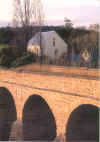
|
“MILL HOUSE” (c1850) – A
former steam mill, it was later used as a butter factory. The artist John Eldershaw lived here during the 1920s. The building is now used as bed and breakfast accommodation. |
|
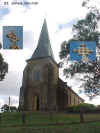
|
ST JOHN’S ROMAN CATHOLIC CHURCH (1837)
This is the oldest Roman Catholic Church still in use in Australia The church has had three spires, with the present one raised in 1972. |
 |
ST JOHN’S SCHOOL – St. John’s School is the oldest Roman Catholic school in Australia. It was established in the 1840s. |
 |
“LAUREL COTTAGE” (c1830s) –
A colonial cottage located in Wellington Street, it is now used as colonial bed and breakfast accommodation. |
 |
“UNION HOTEL” (c1841)
– The “Union Hotel” was operated by emancipist Simon McCullough who is said to have been granted his freedom after helping catch a murderer. It is now a private residence. |
|
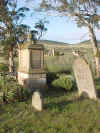
|
ST LUKE’S BURIAL GROUND –
The cemetery is one of a few in Tasmania which have been in continuous use since the early 19th century. It contains the graves of many of Richmond’s pioneers. Convicts dying in servitude were buried in unmarked graves. |
 |
“SAWYER’S ARMS”
(c1844) – Frances Atkinson was the licensee of the “Sawyer’s Arms” in 1844. It continued as an inn until the late 19th century. It is now a private residence. |
 |
“LANDFALL” (c1846)
This cottage was once owned by the Burn family. It is now a private residence. |
 |
‘ECONOMY HOUSE” (c1850) –
Like many Richmond buildings, “Economy House” was used as a shop and later changed back to a family residence. |
 |
COTTAGE – FRANKLIN STREET – FIREMARK – In early days, if your house caught fire and it was insured, theoretically, that company’s fire cart would come to put the fire out. Each insurance company had its own firemark which was displayed prominently for the fire cart to see. Until recently, the firemark was still fixed over the
front door of this cottage. |
 |
“RICHMOND BARRACKS”
(1830s) – This building is believed to have been military barracks. It was later turned into conjoined cottages and is now used as colonial bed and breakfast accommodation. |
 |
“GRANNIE RHODES’ COTTAGE” (c1840s)
This building is known as “Grannie Rhodes” Cottage” after a former resident who is said to have lived to more than 100. This cottage is the only one left in Richmond with no electricity or water. It has been restored to show the 1830’s – 1880’s |
 |
COLONIAL COTTAGE (c1830s)
– This cottage in Bathurst Street was built on land which belonged to John Sewell. Old photos show it with dormer windows, now removed. It was formerly the residence of one of the last blacksmiths in Richmond. |






























































